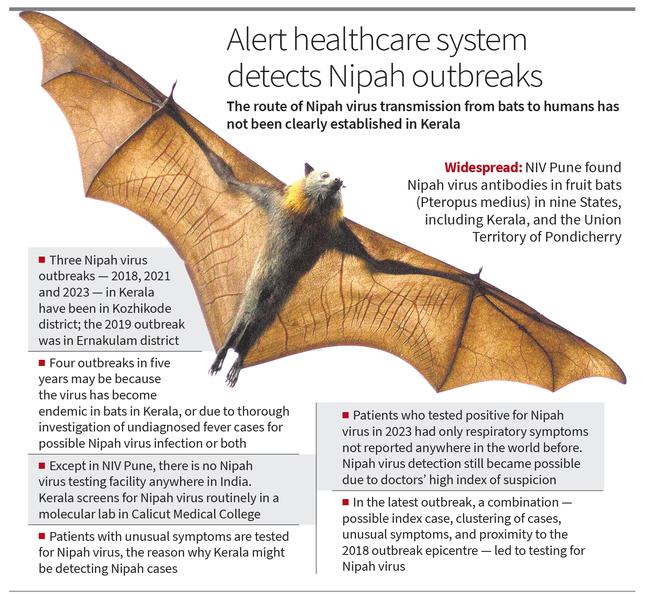Since May 2018 when Kerala reported the first Nipah outbreak in Kozhikode district, there have been three more outbreaks of Nipah virus including the latest one in late-August 2023. For reasons still not known, three of the four Nipah outbreaks in Kerala in 2018, 2021 and 2023 have been in Kozhikode district; the 2019 outbreak was in Ernakulam district.
(For top health news of the day, subscribe to our newsletter Health Matters)
Even five years after the first outbreak in Kerala, and four outbreaks in all, it is still unclear why three of the four outbreaks have been in Kozhikode district in Kerala. Fruit bats that can cause Nipah virus outbreaks in humans are not restricted to Kozhikode district.
As per a 2021 study, Nipah virus was found to be in circulation in fruit bats (Pteropus species) in “many districts” in Kerala. An ongoing nationwide survey in 14 States by NIV Pune has found Nipah virus antibodies in fruit bats (Pteropus medius) in nine States, including Kerala, and the Union Territory of Pondicherry.
While date palm sap was linked to Nipah virus outbreaks in Bangladesh, and pigs acting as intermediate hosts were responsible for Nipah outbreaks in Malaysia, the route of virus transmission from bats to humans has not been clearly established in Kerala.
The four outbreaks in five years may be because the virus has either become endemic in bats in Kerala or is a reflection of Kerala’s superior healthcare system that thoroughly investigates undiagnosed fever cases for possible Nipah virus infection or both. However, with fruit bats positive for Nipah virus antibodies being found in other States, it is likely that Nipah virus infection and deaths may be going undetected in other States while they get picked up in Kerala, especially in Kozhikode district.
“Whenever we have undiagnosed fever cases, a team involving virologists is formed and we undertake a detailed investigation which helps us diagnose Nipah virus and other new virus outbreaks early. In other States, Nipah cases might be going undetected,” says Dr. Anoop Kumar A.S., Director of Critical Care Medicine, North Kerala Cluster, Aster MIMS Calicut, Kerala. Dr. Kumar played a pivotal role in detecting the Nipah virus outbreak in Kerala in 2018 and 2023. “Early lab confirmation, healthcare system acting fast and immediate public health response in Kerala has helped contain the outbreak quickly each time.”
In the 2019 and 2021 outbreak, there was only a single case without any human-to-human transmission. “Nipah virus infection and deaths might have happened in different parts of India in people with undiagnosed fever, which might have gone undetected. Also, there is no Nipah testing facility anywhere in India except NIV Pune. Only Kerala screens for Nipah virus routinely in a molecular lab in Calicut Medical College,” he says. “While other States may not be routinely sending samples for Nipah virus testing, we test for Nipah whenever there are cases with unusual symptoms. That might be the reason why Kerala is detecting Nipah cases.”

Usually, people with Nipah virus infection present with encephalitic symptoms. But in the latest outbreak, patients presented with pure respiratory symptoms, not reported anywhere in the world before. “But we could still identify them as Nipah only because we have a high index of suspicion,” says Dr. Kumar.
In 2018 and in 2023, the index case had died with encephalitis in 2018 and severe pneumonia in 2023 that went unnoticed. In 2018, a cluster formed and Nipah virus was diagnosed among three contacts who were admitted with unusual symptoms about two weeks after the death of the index case. “There was a [possible] index case, clustering and unusual symptoms seen in the contacts. There was a high index of suspicion and that led us to diagnose Nipah virus in 2018,” recalls Dr. Kumar.
In the latest outbreak too, there was a death in another hospital in Kozhikode city on August 30 and four of the family members developed unusual symptoms on September 9 and were admitted two days later at Aster MIMS Calicut. Nipah virus was diagnosed the very next day after admission. “We noticed a clustering of cases after the death of the person. During a detailed history taking we came to know that the person who died had unusual symptoms. And the family was from a locality quite close (10-15 km) to the 2018 outbreak epicentre. There was a high index of suspicion of a new emerging virus or Nipah due to the combination of a [possible] index case, clustering of cases, unusual symptoms and proximity to the first outbreak epicentre. So we first tested for Nipah virus,” he says.
At the time the deaths happened in the index case in 2018 and 2023, Nipah virus was not diagnosed. In 2019 and 2021, only a single case was detected (ending in death in 2021 unlike in 2019). This raises the possibility of several people getting infected with Nipah virus and even dying without a diagnosis in other parts of Kerala and other States, especially when only one or a few cases occur, he says.
The Nipah virus has low infectivity (R0 of 0.2-0.3 compared with R0 of over 1.5 in the case of SARS-CoV-2 virus). “The infectivity from first-degree to second-degree patients is low when infected with Nipah virus but high in the case of index cases,” Dr. Kumar explains. In 2019 and 2021, the infectivity of even the index case might have been less as they had only encephalitis symptoms, which reduces the chances of virus spread, he says while explaining why there were no secondary cases then. Also, every Nipah virus index case need not turn out to be a superspreader.







